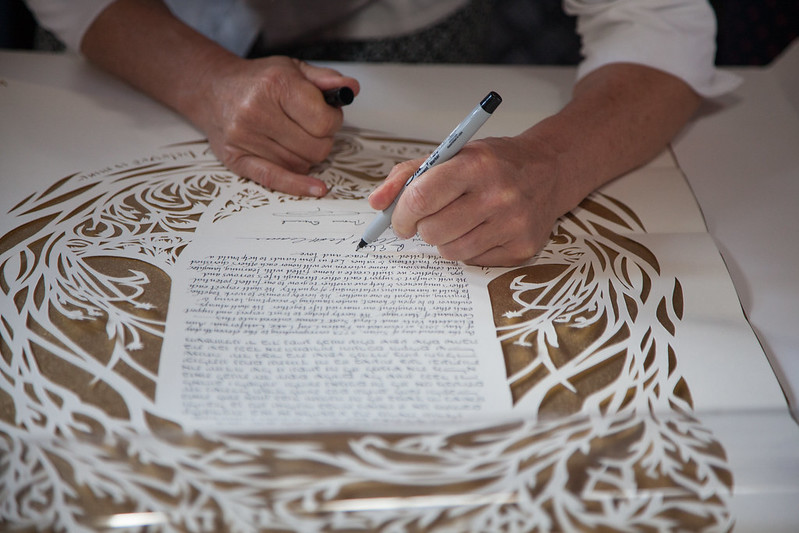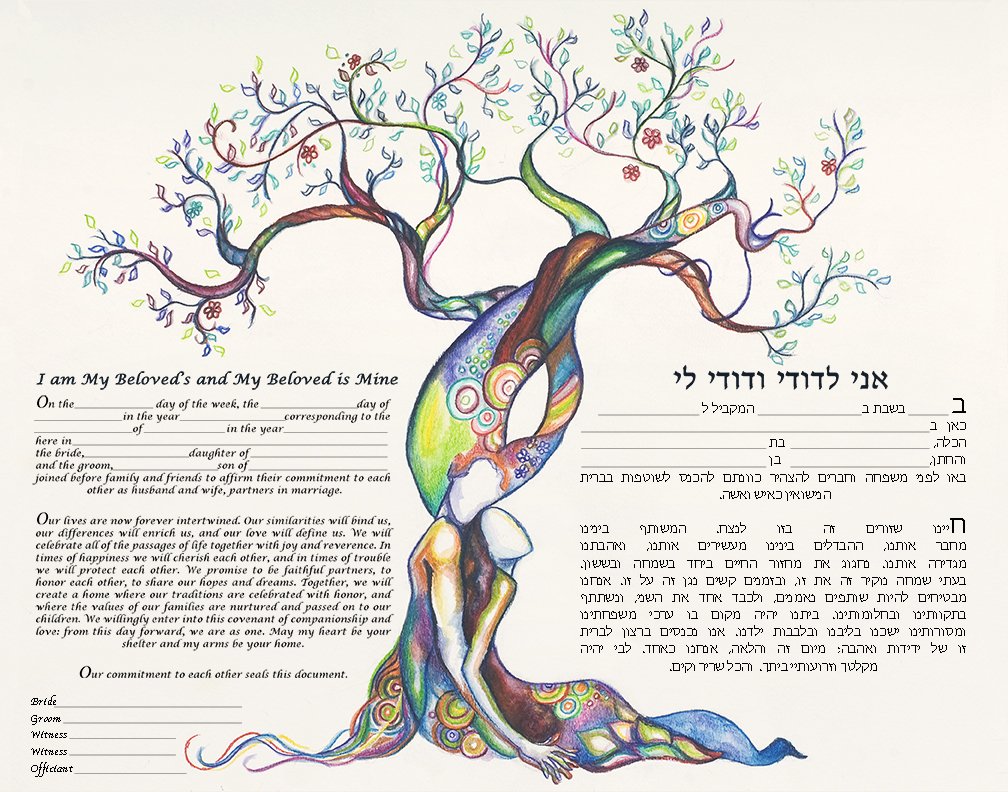Continuing along with the Marriage series, this week I’d like to explore the unromantic ritual known as the Ketubah (or Kesubah if you’re Ashkenazi). Prior to the chuppah ceremony, the kallah (bride) sits on a throne-style chair, surrounded by her friends and family as she gives blessings to a line of guests. Meanwhile, the choson (groom) gathers with his buds who drink l’chiams (though the choson himself is likely fasting) and reviewing the prenuptial marriage document in question.

What exactly is the ketubah and why is it a staple of the Jewish wedding ceremony?
Emotion Paired with Logic
To be clear, the ketubah is not prayer. There are no verses of scripture and there is no mention of God. It is also not a “marriage license.” It doesn’t involve the state in any way. It is also not the “real marriage act” itself. Earlier I described that technically a Jewish wedding is an acquisition. But this ketubah is not a bill of sale, nor is it a receipt. It is also not traditionally signed by the choson or kallah, only the witnesses. Lastly, it is not the statement of love, or vows that you might see at a non-Jewish wedding before the officiant says, “you may now kiss the bride.”
So… what is it?
At its core, the ketubah is a unilateral agreement to establish fundamental conditions of the marriage. The text is written not in Hebrew, but Aramaic, the language of the Talmud. It lays out specific obligations the husband is required to provide his wife, it details monetary compensation to the wife in the case of divorce (God forbid), includes a bit about a dowry, some notes about property, and finally the witnesses’ signatures attest that the couple agreed to the document of their own free will. Though there are some sections that have been or can be added which speak of promises to love and support the spouse emotionally, the ketubah really is a terse legal document. In all likelihood, this highly legalistic text is surrounded by beautiful art, framed, and hung in the married couple’s future living room. Maybe this artistic tradition should be extended to deeds of houses, car titles, and end user license agreements as well.
Why should this contract be so terse on a day of such supreme emotion?
We all know that the worst decisions are made purely based on emotion. If you ever want to sell something, give your perspective buyer an arbitrary ticking clock. Tickets are selling out! Only available till midnight! The worst thing to do when making the biggest decision of your life would be to remain ignorant of the work necessary to make the union successful and to disregard the consequences should the marriage fail. So the Rabbis instituted this practice (though some argue it is mandated by the Torah) to appeal to the sober mind of the participants. Know what you’re getting yourself into.
Superficial Requirements?

The obligations that the husband takes on as outlined by the ketubah are the following; sustain the wife (meaning supplying food), provide clothing (but also bedding and other day to day needs), and conjugal rights (required for the woman, not the man). Why does the ketubah identify these of all things and not “to love and to cherish” or “in sickness and in health”?
Opposites don’t really attract.
The models for romance in our modern world is usually of two star crossed lovers, who against all odds overcome the biases and boundaries to show their love conquering the most stark of differences. The most unlikely relationships make for the most dramatic movies. However, in reality, it’s similarities that really bring us together. Shared values, shared traditions, shared loves. I mean, would a paleo style carnivore really work with a vegan? When the ketubah insists the husband must provide the wife’s clothing, it can’t be done to his level of sufficiency. It has to be to her level of honor. If he grew up on a farm, but she grew up in high society New York, is the husband going to be able to give her the life she’s accustomed to? This requirement functions not only as a dose of reality, but to remind the choson that he’s not what is number one anymore. He’s going to have to think of the emotional needs of his wife.
Obligated gifts.
With Torah laws, you’re not free to disregard them if you’re not feeling it. If you had a bad week, you don’t get to skip Shabbos. These ketubah obligations are fixed as if they were Torah laws. Just because you’re not getting along with your wife doesn’t mean you can withhold supporting her. In secular weddings, sentiments such as “to have and to hold” are vague with no real way to measure if they are objectively being met. That’s not the case with the ketubah’s criteria. When the care and support are prescribed, there’s a much better chance that the positive emotions will return as inspiration follows action and not the other way around as we might think.
Making Divorce Difficult
It’s no surprise that women have been in less than advantageous positions for the vast majority of history. Judaism was one of the first cultures to award women rights when they entered into marriage. Including what happens should that marriage end. Though Judaism doesn’t love the idea of divorce, it does acknowledge that sometimes it is better for a couple to not stay together. (I’m not going to tackle the concept of a gett or agunah here, that’s above my pay grade.) However, just because Judaism recognizes that sometimes divorce needs to happen, that doesn’t mean it should be an easy process. Doing so requires going to a Jewish court and paying the woman an amount for support.
It is certainly an unpleasant sentiment to consider on the day of the wedding. For that very reason, non-Jewish prenuptial agreements are considered a lack of confidence in the marriage, if not outright insulting. But just because a scenario is difficult to imagine, that doesn’t mean you shouldn’t plan for the possible eventuality. Judaism establishes the precedent for every couple, regardless of class, financial level, or age, that they need to acknowledge that if they don’t put some hard work into their marriage, everything could fall apart.
More Than Just a Contract
Jewish law dictates that the couple must always know where their ketubah is located. And if it is lost, must be replaced. In fact, according to The Jewish Way of Love and Marriage, “When the Jews of France were robbed of all their possessions and expelled… in 1306… the Rashba ordered that no married life be resumed there until every man gave his wife a replacement ketubah. ” The ketubah acts as a baseline for the needs of the relationship and it does so in writing. As the couple grows and changes, sometimes closer but sometimes during struggles, it is essential they have that baseline to refer back to. Where a contract is an agreement that allows both parties to benefit from each other, it usually doesn’t pay mind if it does so at one of the party’s expense. A covenant, however, is a bond that specifically aims to make both parties happy and the benefit comes from that. To showcase that agreement front and center in the home of that family is not only a testament to commitment, but an honoring of what a Jewish marriage is founded upon. So now it makes a little more sense why so many Jewish couples frame the framework.



Succintly and beautifully written, to dispel many misunderstandings and misgivings.
Shabbat Shalom!
LikeLike
Thank you so much! And thanks for always supporting the blog!
LikeLiked by 1 person
My pleasure! You should see my Kesubah – it was created by an artist friend as a wedding gift for us and it expresses our personalities pictorially, with quotes from Shir haShirim in two languages.
Shabbat Shalom and a Hag Purim Sameach!
LikeLiked by 1 person
How important is it that the ketubah be displayed in the living room? My friend has his up in their bedroom.
LikeLiked by 1 person
I don’t actually know the halacha, but I don’t believe the ketubah actually needs to be displayed at all. The couple just needs to know where the ketubah is. I would guess that there is no problem with it being in the bedroom.
LikeLike